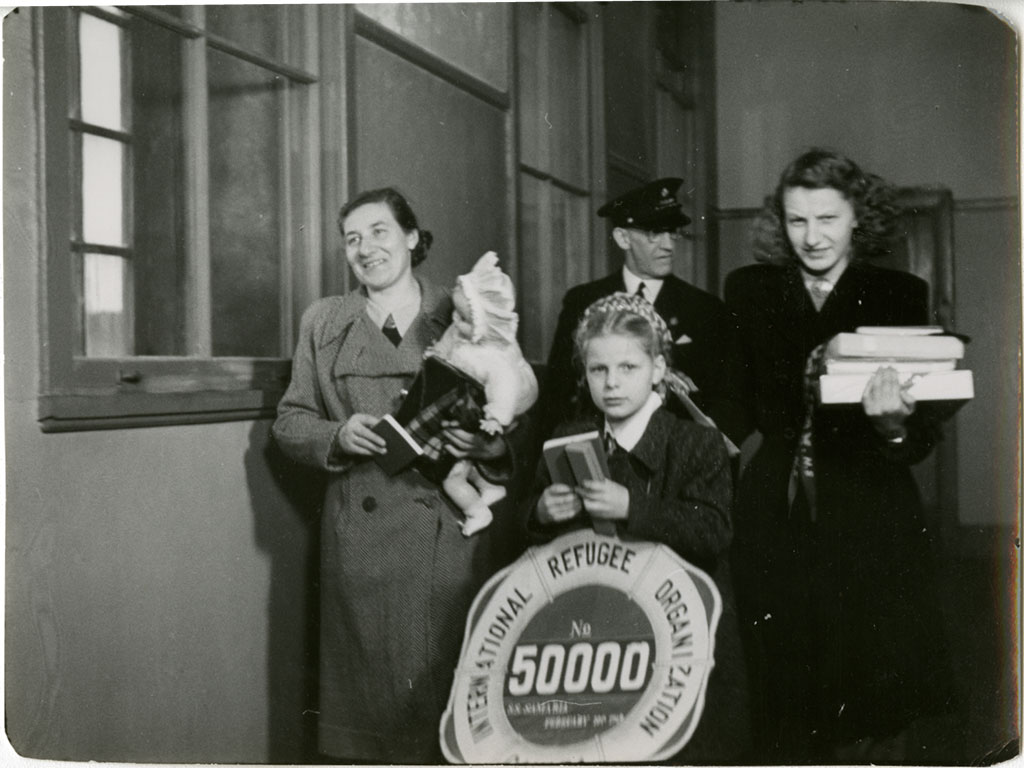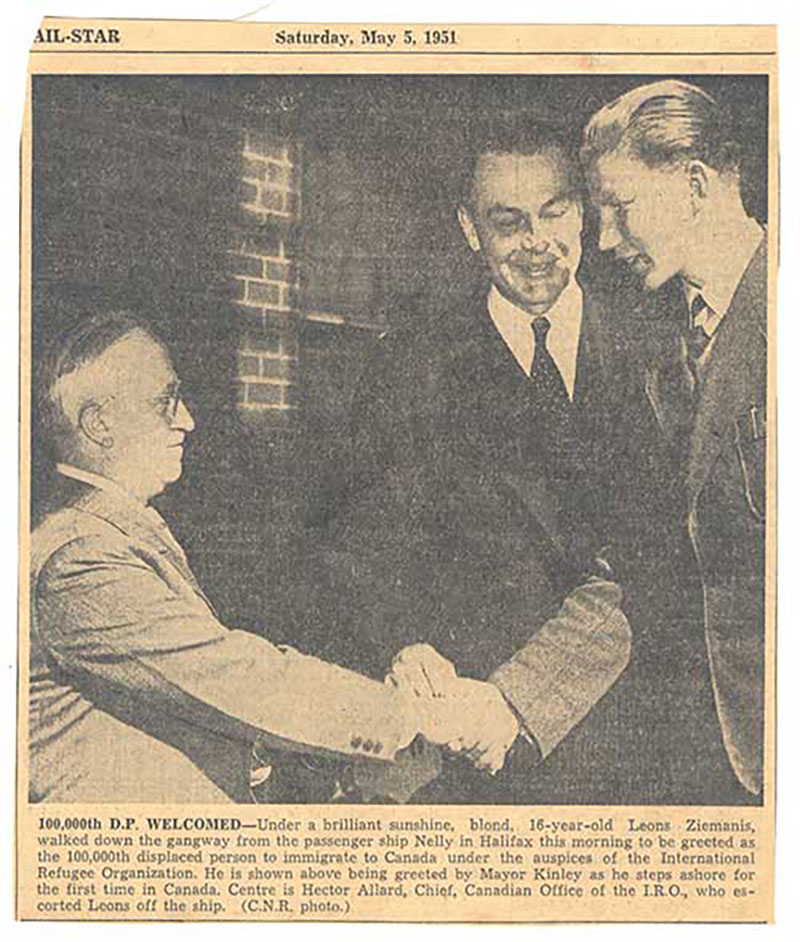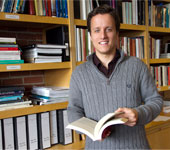by Jan Raska, PhD, Historian
(Updated October 26, 2020)
Introduction
During the early postwar period, Canadian officials attempted to commemorate immigration milestones. These official commemorations were in response to postwar immigration policies that had opened Canada’s doors to tens of thousands of European immigrants including displaced persons and political refugees in an attempt to fill a shortage of labour in Canada, and to alleviate the humanitarian crisis in war-torn Europe. These highly publicized receptions which included photo-ops, speeches, and gift-giving were used as a mechanism from which federal immigration officials could showcase that the ‘preferred’ or ‘ideal’ immigrant was white, young, preferably British, with the potential to become successful in Canada. Federal immigration officials also demonstrated an ethnocultural preference or bias for Baltic refugees over other more sizable European nationalities from which large groups of postwar immigrants resettled in Canada. Historian and archivist Kerry Badgley notes that in the mid-1950s, federal officials used the commemoration of immigration milestones as a strategy to raise awareness and promote a positive view of Canadian immigration among the broader public, even resorting to deception in an effort to reach their goals.[1]
Below are five instances in which federal officials organized a reception commemorating a national immigration milestone or prevented such an event from taking place.
Canada’s 50,000th Displaced Person (DP)

Credit: Canadian Museum of Immigration at Pier 21 Collection (D2013.1912.24)
In an effort to turn public opinion towards DP resettlement as a means to fill Canada’s postwar labour shortage and to provide a humanitarian response to the plight of Europe’s displaced and persecuted, Canadian immigration officials chose a young, blond-haired, Baltic girl as Canada’s 50,000th DP under the International Refugee Organization (IRO)’s resettlement plan. On 17 February 1949, the Montreal Gazette reported that the previous evening Canadian officials had chosen eight year-old Latvian DP Ausma Levalds. While it is not clear why the young Latvian was chosen, six days later, Levalds, her mother Karline, and sister Rasma landed at Halifax aboard SS Samaria.[2]
That morning Levalds received a large reception in which she was greeted by Canadian officials in the immigration shed, while radio and newspaper outlets gathered and took photos of her reception. The Globe and Mail claimed that “Canada’s 50,000th DP Starts New Life in New Home.”[3] Levalds was one of 1,200 DPs who had departed Europe from Cuxhaven in Allied-occupied Germany, for new homes in Canada. The young blond newcomer was presented with a fruit basket and a book about Canadian birds by federal immigration officials, a doll by Halifax Mayor John E. Ahern, and a locket from his wife. Levalds reminisces about the difficulty of being chosen for such an immigration milestone…
And then just being kind of holden here and there for the photographers and not understanding what the dickens was going on, but always being taught to be quiet, not to say anything, to smile, to curtsy. So those good rules stood me well kind of thing. And the presentation of the doll from Mayor Ahern, and his wife the locket. And I had the bird book. And, um, I find it still difficult to look at that film, with all the people behind me and they—having to watch someone being made a fuss over when they were just as deserving of being made a fuss over.[4]
Levalds soon departed Pier 21 by train to rejoin her father Janis, who was a farmer’s helper at the Greulich farm in New Hamburg, Ontario.[5] While the family was successfully reunited in Canada, other DPs continued to make the transatlantic journey in search of a new life.
Canada’s 100,000th Displaced Person (DP)
On 4 May 1951, SS Nelly made its first call to the port of Halifax landing at Pier 21 with 1,300 European DPs aboard. Due to the ship’s late arrival and the large number of passengers to be cleared, Canadian immigration officials decided to begin disembarkation the following morning. Federal officials were aware that among the ship’s travellers was the 100,000th DP to immigrate under the auspices of the IRO. Accompanied by his parents Pauls and Nora, and siblings, Janis, Rita, and Juris, a tall and blond sixteen-year-old Latvian DP, Leons Ziemanis, was welcomed by Hector Allard, chief of the Canadian office of the IRO and Hubert M. Grant, district superintendent of Immigration for the Atlantic Region. The next morning, Ziemanis walked down the gangway from SS Nelly and entered Pier 21’s assembly hall to the sounds of “O Canada.” He was then greeted by Halifax Mayor Gordon S. Kinley, J.L. Podoski, Canadian National Railway (CNR) port reception officer, and R.P. Hartley from the Department of Labour in Moncton.

Credit: Canadian Museum of Immigration at Pier 21 Collection (R2014.336.1)
After a round of speeches on the part of various officials, Ziemanis spoke briefly before the crowd in attendance, stating “Thank you, everyone. Thank you, Canada. This is the greatest day of my life. I cannot yet believe that we have arrived in our new country and that we are no longer displaced persons. It is not very good being a displaced person. For six years–since my family, had to flee Latvia–we have been without a home and without a country. But for the help of the International Refugee Organization we should also have been without hope.” Ziemanis later added that “all I can say today is that it is wonderful to be wanted and to belong to a country again.”[6] The young man was later scheduled to tour the city before boarding one of four CNR boat trains to operate from the dockside, and head for his new home in Toronto.[7]
Canada’s Millionth Immigrant since 1945
Approximately three years after Ziemanis, in mid-1954, the Canadian government was preparing to welcome the millionth immigrant to Canada since the Second World War.[8] That year, federal immigration officials admitted 154,227 immigrants, or 1 percent of the Canadian population.[9] In referencing Prime Minister Mackenzie King’s 1947 speech before the House of Commons about immigration not fundamentally altering the character of the nation, Citizenship and Immigration Minister Walter Harris outlined his views regarding postwar immigration before the press. He noted that the Canadian government “had always felt the greater portion of immigrants should come from the United Kingdom. At the same time, one cannot disregard the advantages of having a mixed population and of adding to those other national groups already here who have demonstrated their ability to adapt themselves to Canadian conditions.”[10]
At the end of April 1954, the Department of Citizenship and Immigration discussed arranging a ceremony for “Mr., Mrs., Miss or Master Million” who would attend the annual convention of the Association of Canadian Advertisers in Toronto from 4 to 7 May 1954. When E.B. Reid, chief of information services for the Department, failed to produce the millionth immigrant before the press, Immigration Minister Walter Harris was forced to concede before the House of Commons that “no one seems to know who he is or she might be.”[11] The Canadian press found the situation preposterous, questioning how could immigration officials keep such exact figures on immigrant entry when they could not keep mathematical track of immigration. Harris later claimed that the proposed ceremony was cancelled on the grounds that Canada should not “recognize one or more than another. We feel that they are all good, all desirable and all welcome.” The Canadian press noted that choosing the millionth immigrant would have honoured, not annoyed the 999,999 who came before him or her.[12]
Canada’s 2 millionth immigrant since 1945

Credit: William McFaul, 5 December 1960. Canadian Museum of Immigration at Pier 21 Collection (D2014.10.24).
In late 1960, Canadian immigration officials contacted the officer-in-charge in Copenhagen to assist them in selecting a Danish immigrant as Canada’s 2 millionth immigrant since 1945. Why the Minister of Citizenship and Immigration chose a Danish immigrant is unclear, but immigration officials soon focused on David Toft, who had arrived in Canada on 8 October 1960. The officer-in-charge informed his colleagues in Ottawa that Toft’s family would be immigrating to Canada in the near future. Federal officials sought to learn as much as possible about the family and had no preference as to whether the son or daughter was selected for the immigration milestone.[13]
Sixteen-year-old Dane, Anette Toft, along with her mother and younger brother, disembarked from the Polish ocean liner MS Batory at Quebec City’s Champlain Harbour Station, on 3 December 1960. According to a Canadian Broadcasting Corporation (CBC) news report, the young immigrant “rushed ashore at Quebec City into the arms of her father...the family will move to Calgary where Mr. Toft hopes to establish his own business.”[14] Still an adolescent, Anette Toft had been trained as an interior decorator and worked in a large department store in Denmark. In preparation for their move to Canada, the family learned English. For over twenty years, the Tofts had hoped to permanently resettle in Canada.
Upon her arrival, Toft was greeted by public officials, the press, and curious onlookers. She was given a white sash which she wore over her right shoulder. The sash indicated the ship that had brought her to Canada, and her new status as the 2 millionth immigrant.[15] Toft attended a reception celebrating the immigration milestone where Citizenship and Immigration’s Eastern District Superintendent, William McFaul, read out loud a telegram from the federal minister. The telegram was written days earlier and sent to the CN Telegraphs printer in preparation for the milestone reception, in which Toft’s selection was to appear to the public as a random selection. In reality it had been carefully planned and coordinated.[16]
Canada’s 10 millionth immigrant since 1867
In 1972, Dr. Richard P. Swinson, a British psychiatrist from Leek, Staffordshire, England was chosen as the 10 millionth immigrant since 1867. Swinson landed at Toronto International Airport with his wife, Carolyn, sons Ian and Robert, five and six years old, respectively, and daughter Catherine, three years old (see image of their arrival here).[17] Swinson had accepted an offer to work at St. Michael’s Hospital in the city. Labelled by federal officials as the “ideal family,” the Swinsons were personally welcomed to Canada by Minister of Manpower and Immigration Bryce Mackasey. The Department of Manpower and Immigration (DMI) organized a media event to celebrate this entry of Canada’s 10 millionth immigrant since Confederation. Historians Sasha Mullally and David Wright note that this celebration was part of a plan by federal immigration officials to diminish public anxiety over immigration. Following the liberalization of Canadian immigration policy with the implementation of Order-in-Council P.C. 1967-1616 (commonly referred to as the points system) in 1967, tens of thousands of individuals from non-traditional countries resettled in Canada.[18]
What the Canadian press initially believed was a random selection to determine the 10 millionth immigrant, was actually heavily biased towards the requirements set by the Immigration department. Canadian immigration officials had created a shortlist of recently accepted immigrants based on factors including occupation, age, and intended place of residence. According to the DMI, the successful candidate was to be a married male with children, under the age of thirty-five, who wished to resettle in the region of Toronto. Swinson had made the shortlist along with six other finalists. Immigration bureaucrats found it difficult not to select the British physician, since “we didn’t want to [select] a guy who will be unemployed in two months or take a job from a Canadian.”[19] Another bureaucrat claimed that the selection could have been more reflective of immigration trends with respect to the large number of American immigrants entering Canada, stating “…it might have been more appropriate if number 10 million had been a heart surgeon from Houston…”[20] Although the unnamed immigration official had a valid point, the choice of a white British physician spoke volumes about existing ethnocultural preferences given that Canada’s doors had flung wide open to immigration from around the world just five years before Swinson’s arrival.
Conclusion
Successive postwar Canadian immigration departments attempted to use milestone commemoration as a mechanism to disseminate their visions of the ‘ideal’ immigrant – a European, preferably of British origin, from a respectable family, young, and potentially successful. When a British immigrant was not selected for a particular immigration milestone, Canadian immigration officials followed existing ethnocultural preferences and sought clean, industrious, resourceful, and well-mannered Baltic DPs.[21] Badgley is right to point out that such efforts were meant to educate fellow Canadians on the need and desirability to accept postwar immigration, but often led to schemes that were seen by the public as condescending and tainted by official biases and actions.[22]
The selection of two young and photogenic Latvians for Displaced Person (DP) milestone commemorations speaks loudly about bureaucratic preferences, since far more Polish, Soviet, and Yugoslav citizens entered Canada in the first decade after the Second World War.[23] In the case of Swinson’s selection, it is understandable that Canadian immigration officials hoped to choose a British citizen for an immigrant milestone. Between 1946 and 1972, the largest group to enter Canada were over 1 million immigrants from Britain and the colonies, followed by over 477,000 from Italy, over 329,000 from the United States, and 280,000 from West Germany.[24]
During the selection scheme that ultimately chose Richard Swinson as Canada’s ten millionth immigrant since Confederation, Canadian immigration officials had a tremendous opportunity to demonstrate the effects of policy liberalization–after the introduction of the points system and the implementation of an official Multiculturalism Policy–by choosing an immigrant from a non-traditional source country. Instead, they opted to follow existing statistical trends.
- For context, see Kerry Badgley, “As Long as He is an Immigrant from the United Kingdom”: Deception, Ethnic Bias, and Milestone Commemoration in the Department of Citizenship and Immigration, 1953-1965,” Journal of Canadian Studies 33.3 (Fall 1998): 130-144. The quote “eminently suitable for our purposes” which forms a part of the blog title can be found on page 134.
- Newspaper clipping. Canadian Museum of Immigration at Pier 21 (hereafter CMI) Collection (R2013.841.20). Clipping is of the article, “Eight-year-old Latvian Girl Chosen As 50,000th D.P. Under IRO Plan,” Montreal Gazette, 17 February 1949.
- “Canada’s 50,000th DP Starts New Life in New Home,” Globe and Mail, 26 February 1949, 17.
- Oral History with Ausma Levalds Rowberry, interviewed by Steven Schwinghamer, Halifax, 31 July 2002, CMI Collection (02.07.31ALR).
- “Canada’s 50,000th DP Starts New Life in New Home”.
- “100,000th European D.P. Welcomed at Halifax,” Halifax Mail-Star, 5 May 1951, 1, 6.
- “100,000th European D.P. Welcomed at Halifax;” “100,000th DP, Count and Wife Toronto-Bound,” Globe and Mail, 7 May 1951, 12.
- For an excellent overview, see Badgley, “As Long as He is an Immigrant from the United Kingdom.”
- Canada, Department of Citizenship and Immigration, “Canada Facts and Figures 2014: Immigrant Overview – Permanent Residents,” https://publications.gc.ca/site/eng/9.512569/publication.html.
- “Millionth Immigrant Since War Due in ’54,” Globe and Mail, 12 January 1954, 15.
- “Missing Millionth,” Globe and Mail, 26 May 1954, 6.
- “Missing Millionth.”
- Badgley, “As Long as He is an Immigrant from the United Kingdom,” 138.
- Canadian Broadcasting Corporation (hereafter CBC), “1960: Canada celebrates two millionth immigrant since 1945,” 6 December 1960, CBC Archives, http://www.cbc.ca/archives/entry/1960-canada-celebrates-two-millionth-immigrant-since-1945.
- CBC, “1960: Canada celebrates two millionth immigrant since 1945.”
- Badgley, “As Long as He is an Immigrant from the United Kingdom,” 139.
- For an image of the Swinson family’s arrival, see Toronto Public Library, Toronto Star Photo Archives, Frank Teskey, photo, “10-Millionth Immigrant; Canada's 10-millionth immigrant since Confederation; Dr. Richard P. Swinson; a psychiatrist from Leek; Staffordshire; England; arrives at Toronto airport with his family - wife; Carolyn; and children Ian; 5; Catherine; 3; Robert; 6,” tspa_0023843f, 1972. http://www.torontopubliclibrary.ca/detail.jsp?Entt=RDMDC-TSPA_0023843F&R=DC-TSPA_0023843F.
- Sasha Mullally and David Wright, “Doctors on the Move: Physician Migration and Canadian Immigration History” CIHS Bulletin 77 (June 2016): 1-2.
- John Clarke and David Wright, “Too Many Doctors? Foreign Medical Graduates and the Debate over Health Care Accessibility in Canada, c. 1976-1991,” Canadian Bulletin of Medical History 30.1 (2013): 168.
- Clarke and Wright, “Too Many Doctors?”
- See Ben Shepard, The Long Road Home: The Aftermath of the Second World War (New York: Knopf, 2010), 336. Canada’s High Commissioner in London, Vincent Massey, reported from Occupied Germany in 1945 that the Balts, and in particular the Latvians “might be the best of the lot.” He went on to inform Canadian officials that these DPs were industrious, clean, resourceful, and well-mannered. When it came to the Poles, for example, “one did not want too many of them about.”
- Badgley “As Long as He is an Immigrant from the United Kingdom,” 140.
- Between 1946 and 1955, only 13,737 Latvian citizens entered Canada. This is far less than the 104,450 Polish, 20,953 Yugoslav, and 18,010 Soviet citizens who were admitted into the country. See Canada, Department of Manpower and Immigration, 1966 Immigration Statistics (Ottawa: Queen’s Printer and Controller of Stationery, 1967), 26.
- Between 1946 and 1972, 1,044,692 individuals gave Britain and her Colonies as their country of citizenship, followed by 477,673 from Italy, 329,676 from the United States, and 280,886 from West Germany. See Canada, Department of Manpower and Immigration, 1972 Immigration Statistics (Ottawa: Information Canada, 1974), 22.
